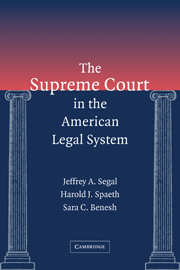Book contents
11 - Getting into Court
Published online by Cambridge University Press: 05 June 2012
Summary
Assertions by persons about to initiate a lawsuit, as well as by those who have already lost, that they will take their case all the way to the United States Supreme Court undoubtedly bespeak their deeply felt intentions, but in most cases their avowals lack credibility. Individuals who wish to file a lawsuit must be proper parties; that is, they must have standing to sue. If they do have such credentials, they must also take their case to the proper forum: The court in question must have jurisdiction – the capability to resolve their dispute. Assuming that the plaintiff is a proper party and is in the proper forum, a third hurdle to Supreme Court resolution remains: The justices themselves must deem the matter worthy of their consideration. The last is by far the most difficult to surmount.
Decisions about access, whether they concern proper parties or the proper forum, may appear to be purely legalistic and to have no policy effects. Not so. “‘Jurisdiction,’ the Court has aptly observed, ‘is a word of many, too many meanings.’” And although its definition does not resolve the merits of cases, it does determine which litigants will obtain a meritorious resolution of their disputes. In this chapter, we present the procedure whereby cases reach the Supreme Court and the factors that affect the justices' decision to accept a case for consideration. We conclude with a discussion of the Court's caseload.
- Type
- Chapter
- Information
- The Supreme Court in the American Legal System , pp. 275 - 298Publisher: Cambridge University PressPrint publication year: 2005



